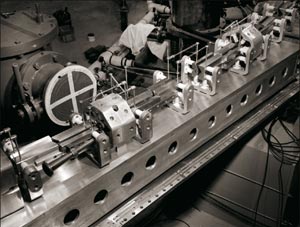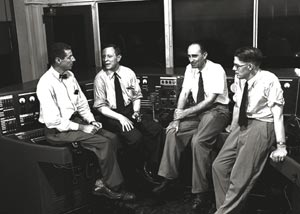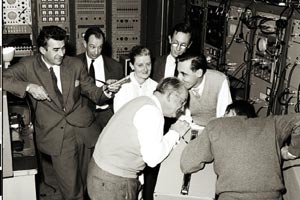Ernest Courant recalls the early days of big synchrotrons.
In the spring of 1947, Philip Morse and M Stanley Livingston visited Cornell University, where I was a post-doc working in nuclear physics under Hans Bethe. They talked about the newly established Brookhaven National Laboratory (BNL), where Morse was the director and Livingston was in charge of a project to build a gigantic accelerator that would reach 3 GeV – which was 10 times what anyone had achieved previously. This fascinated me, and I accepted their invitation to join the project for the summer. I worked with Nelson Blachman at BNL on some of the orbit problems of the proposed machine, and discovered that I enjoyed this type of work. I returned to Cornell, and joined the laboratory permanently the following year.

Image credit: BNL.
The project to build the Cosmotron (so called because it would almost emulate cosmic rays) proceeded, and by early 1952 success was in sight. French physicist Edouard Regenstreif of the University of Rennes visited us in the spring. He represented a consortium of 12 European countries (Conseil Européen pour la Recherche Nucléaire – the provisional CERN) that aimed to establish a new laboratory featuring an accelerator like the Cosmotron, only bigger. We showed him what we had, and he was duly impressed.

Image credit: BNL.
On 20 May 1952, the Cosmotron accelerated a beam of protons to a little more than 1 GeV – by far the highest energy ever attained by artificial acceleration – just 20 years after Livingston and Ernest Lawrence had achieved the first million volts with a cyclotron. The energy soon came close to the design value of 3 GeV and almost immediately we started to ask ourselves how our success could be extended to higher energy. Livingston (who had returned to the Massachusetts Institute of Technology in 1948) came back for the summer to lead a study group.

Image credit: BNL.
A delegation from CERN was due to follow up on Regenstreif’s visit to see whether they could pick up some pointers from us. They were planning to build a proton synchrotron similar to the Cosmotron as the centrepiece of their new international laboratory, but with an energy of around 10 GeV. Our study group considered what advice we could give them.

Image credit: BNL.
The story of how we came upon the “strong focusing” or “alternating gradient” scheme, which enhances orbit stability, has been told many times. The most important consequence of this enhanced stability is that the magnets for an accelerator may be much smaller, making it feasible to go to higher energy at a reasonable cost. We promptly considered the possibility of building new accelerators in the range of 30–100 GeV.

A week or two later the delegation from CERN arrived, comprising Odd Dahl, who had worked with high-voltage machines in Washington before the war; Frank Goward, one of the first people to make a working synchrotron; and Rolf Wideröe, the Norwegian who had first devised a scheme to use radio frequency repeatedly to produce more energy than the corresponding voltage, and whose 1928 paper led to Lawrence’s invention of the cyclotron. The visitors were impressed, and they returned home recommending the new method to build an accelerator for 30 GeV, rather than the planned 10 GeV.
Shortly afterwards, John and Hildred Blewett and I received an invitation to travel to Europe to discuss the new idea with CERN physicists. We set out in November – in sleeper berths on a Boeing Stratocruiser – on a 12-hour, non-stop flight to Paris. We met a number of interested people in a meeting led by Pierre Auger at UNESCO headquarters. It was there that I met Kjell Johnsen, leading to a friendship lasting until his death this summer. A number of people went to Geneva to look at an empty field as a possible site for the accelerator.
I left Geneva for my native city of Göttingen, to give a talk (the only one I have ever given in German) to Werner Heisenberg and people at the Max Planck Institute. I went on to Copenhagen to see Niels Bohr and his people, some of whom had built a mechanical model illustrating how alternating focusing and defocusing can give stability. The Blewetts went to Bergen for discussions with Dahl and I concluded my European trip with a visit to Harwell in England – which, as far as I can recall, is when I first met John Adams and Mervyn Hine.

Image credit: BNL.
Back at BNL, we went to work on exploring the requirements for actually building an accelerator – and of course the CERN people did the same. Both groups decided to aim for an energy of around 30 GeV – and the race was on. However, we collaborated in this race as much as we competed, sharing internal reports and informal communications. The Blewetts took six months’ leave in 1953 to work with Dahl in Bergen. At the time, CERN was scattered over several sites prior to the establishment of the central laboratory in Geneva. At a conference at the University of Geneva in October 1953, participants discussed the theoretical and technical design issues for an alternating gradient synchrotron. I was one of several American participants and Hildred Blewett edited the proceedings – I still have a copy after all these years.
The rivalry and collaboration between the projects at BNL and CERN continued. As a result, the two accelerators are similar in overall design, not only in size but in most of the details. The machine at BNL is called the Alternating Gradient Synchrotron (AGS) and the one at CERN is the Proton Synchrotron (PS); in fact, both names apply to both machines.
There were still some differences. One possible problem was a phenomenon called the “transition energy”, an energy where the mechanism of phase stability demands a sudden change of phase of the accelerating field. All the theory – by Kjell Johnsen at CERN and me at BNL – predicted that this should be easy to deal with. The people at CERN were convinced that this was correct, while some of the powers-that-be at BNL decided that they would feel safer if there was an experimental demonstration of the feasibility of going through this critical energy. As a result, BNL built a small-scale model (the Electron Analog) to verify that calculation, while CERN did not. The Electron Analog worked perfectly, but it cost us some time. Consequently, CERN won the race – they had an accelerated beam in 1959, while ours came in 1960. Each was the world’s highest-energy accelerator when it came on.
There are numerous accelerators and colliders today with energies exceeding the PS and the AGS. These two venerable machines are approaching their 50th anniversaries and are breaking records in longevity rather than energy. They now function as injectors for their successors: the AGS for RHIC at BNL, and the PS for the SPS at CERN – which the LHC will soon succeed. Continued collaboration between BNL and CERN – and other high-energy laboratories around the world – is a matter of course.








